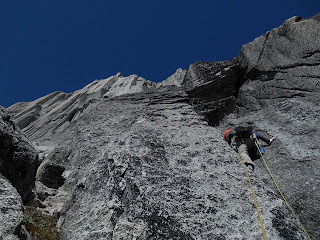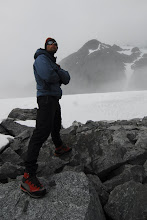In the eight years that I've lived in the Leavenworth area, the Stuart Range has been my training and molding ground. These jagged peaks picked up where the American West left off. After years of dirtbagging in places like Yosemite, J-Tree, and Indian Creek, I "settled down" in Leavenworth, Washington. I didn't realize it at the time, but I was about to become an alpine climber.
Year after year I return to the Stuart Range, seeking new challenges that inspire me. These days, I am most interested in climbing these peaks in winter. A route that would take me half a day in summer all of the sudden becomes a much more complicated affair. The road to the trailhead is closed, adding an extra four miles of hiking on the front and back end of a winter mission. You feel a remoteness that just can't be had in summer and there are so many more variables to consider.
The last few years I have accomplished some of my winter goals. The strong partners I climbed with eased my burden and I enjoyed the camaraderie of our experiences. This winter, I desired something new. I wanted to complete a first winter ascent of an aesthetic route by myself.
My first view of Argonaut Peak on 12/29/2013
Knowing the conditions were fairly dry in the range, I thought a rock buttress would be a good choice. My first thought was Sherpa Peak's North Ridge (someone go get this thing!), an elegant and classic route on a seldom visited peak. Despite being included in Jim Nelson's Classic Climbs book, it had never seen a winter ascent. I considered this option, but also recognized that I would be in Argentina soon and needed to be ready and fresh for the big time. Sherpa was totally doable, but I only had one day to climb in the middle of a busy work week and decided the effort would tap me more than necessary. I finally settled on Argonaut Peak's NW Buttress. It was a shorter, easier route on a mountain I knew fairly well. Most importantly, I thought it was a nice looking line.
NOAA called for sunny skies...should I bail?!
I hiked in after work on Saturday and made camp at the junction where the Colchuck Lake trail branches off the Stuart Lake Trail. There wasn't much snow to that point, but the ice was insane. Every step was tedious and I fell many times. How I wished for more snow!!
After a good nights sleep I set off. The dawn brought a surprise for me. Instead of the sunny skies that were forecasted, the peaks were obscured in windy clouds and snow flurries. As I approached the mountain I could tell that despite dry conditions, the rock was covered in furry white stuff called rime. As wind and moisture raked the peaks, it become more prominent. On the pocket snow field below my route the wind actually pushed me around as I racked up. I wondered if I should bail as the weather was much worse than I imagined it would be. I finally decided I was ok for now and that I should keep going until I couldn't anymore. I climbed a 40 - 50 degree couloir for 400 feet to a notch at the base of the buttress. It was tiring work as the snow was not firm and was the culmination of a 13 mile approach with a heavy pack (you carry all the gear when you solo!).
It's hard to tell, but this step on the buttress involved face climbing verglased 5.6 for 80 meters. I choose to belay myself on this stretch due to the slippery rock. Higher, the rime became so prevalent that everything was covered in the furry white stuff.
It was a cloudy day, but the views from the buttress were still beautiful
Looking up at the route, it was clear I wouldn't be wearing the rock shoes I had brought. It was much to cold and the rime covering the rock would require crampons. I put one ice tool away and clipped the other to my side. I free soloed the first step, but when more difficult ground presented itself, I broke out my rope and belayed myself through the difficulties. The climbing was typical Stuart Range winter fare. Rime covered rock climbing with the occasional stretch of alpine ice and crucial moss sticks.
It was interesting to be in my own world up there. There were points where my eyes followed my rope down into the mist and I almost forgot that no one was down there. I was alone. The weather worsened as I got higher, but I barely noticed as I was so focused. My only hope was that the wind would not pick up more. I didn't have goggles and I knew how debilitating that could be in these conditions. How would I descend if I couldn't open my eyes to see!
On top, hoping that I could see well enough to descend efficiently
After a nice mixed pitch with some actual sticks in ice, I finally hit the summit. I took a quick photo and started descending in high winds. Some down climbing and three rappels put me on the south side of the peak. With darkness only 20 minutes away, I chose not to return via the approach I had taken in the morning. While this approach (Mountaineer's Creek) is not too tricky, it does require off trail maneuvers and I knew in my tired state I would most likely get lost and walk in circles. Therefore, I began a soul sucking trek through shin deep snow around Colchuck Peak. Once I arrived at the col between Colchuck and Dragontail, all I needed to do was descend an easy glacier, after which I would pick up an actual trail that would lead me back to the junction where I had bivied the previous evening.
The rest of my descent was straight forward, but movement was constant. I finally returned to my car at 10:30 PM, seven hours after I left the summit.
Now, I'm drying my gear and packing my bags to head south. This was the last climb before my season in Patagonia begins. I'm ready and psyched.
*An account of the first winter ascent of the NW Buttress of Argonaut Peak
*Summit was gained on December 29, 2013
*Ascent was made by Jens Holsten



























































